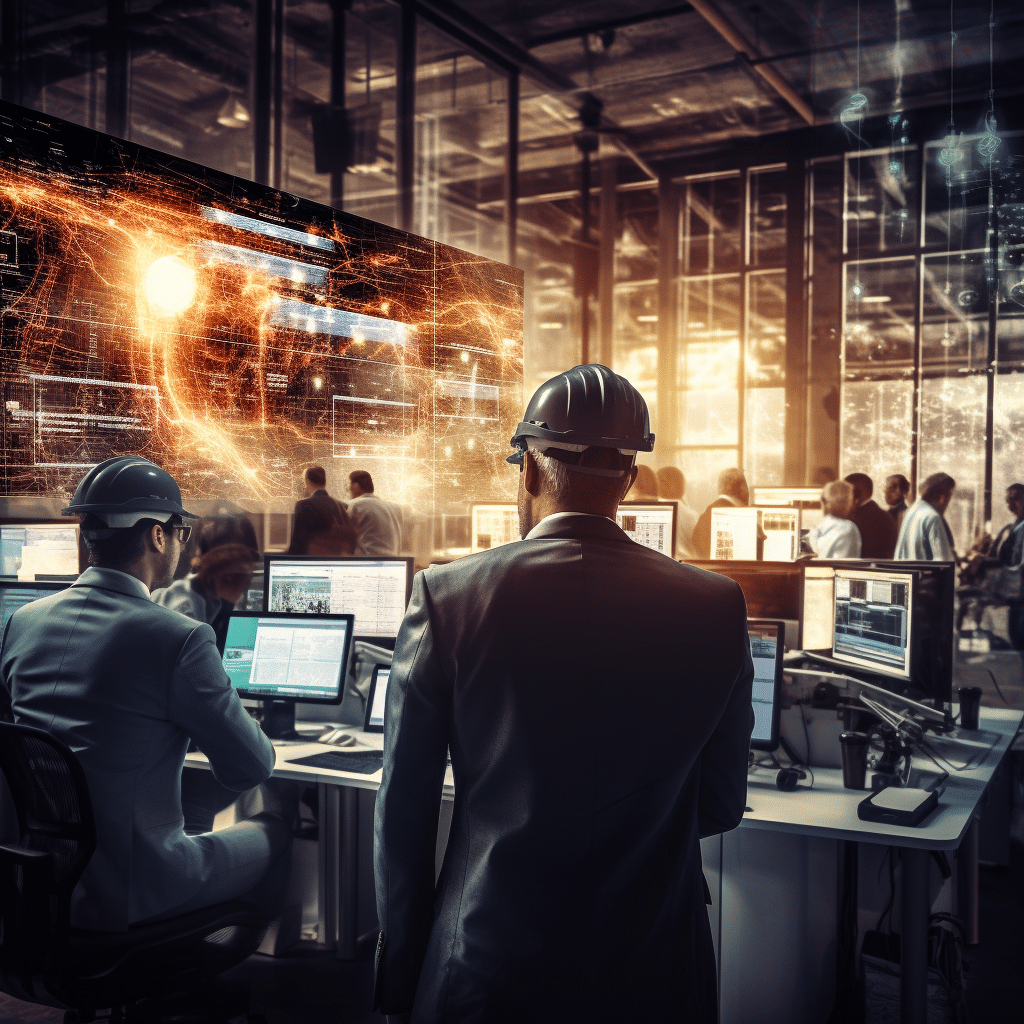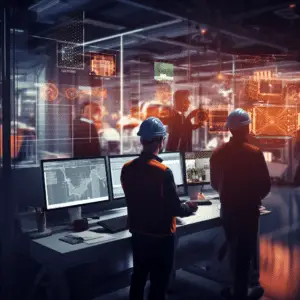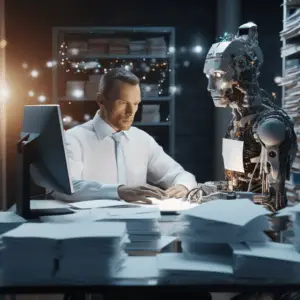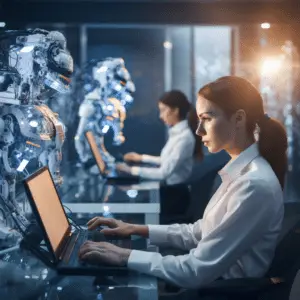
AI and Workplace Safety: A Risk-Reduction Revolution

“AI has revolutionized risk reduction and workplace safety.”
A productive workforce depends on workplace safety. This has required intensive training, strict safety standards, and manual monitoring. AI is transforming risk reduction.
AI’s capacity to swiftly and effectively evaluate large amounts of data helps identify hazards and avoid mishaps. AI systems can spot trends, hidden insights, and potential threats using machine learning methods.
This innovative device uses sensors to continuously monitor and evaluate work surroundings. From smart cameras that can spot harmful behaviors like inadequate protective gear or operating machines outside safety limitations to smart sensors that monitor air quality, sound levels, and temperature, AI helps predict dangers and take preventative measures.
AI improves worker safety greatly. First, AI-powered devices can greatly reduce accidents and injuries. Organizations can improve resource allocation, employee feedback, and correct possible hazards by early identification.
“AI in safety procedures has reduced risks and streamlined processes, saving organizations worldwide time and money.”
Second, AI in safety measures promotes a safety culture. AI systems can give employees real-time safety reminders and encourage risk prevention.
AI algorithms can also find accident-causing tendencies in past data. This data helps firms make data-driven decisions, provide targeted safety training, and strategically spend resources to prevent future mishaps.
Finally, AI in workplace safety is changing risk management. AI can help organizations prevent accidents, identify hazards, and promote safety. AI technology improves procedures, saves time, and lowers risk. AI’s potential impact on workplace safety offers safer working conditions, healthier workers, and more productivity and employee happiness.
How can AI be effectively implemented in the workplace to reduce risks and ensure employee safety?
There are several ways AI can be effectively implemented in the workplace to reduce risks and ensure employee safety:
1. Risk assessment:
AI can analyze large amounts of data to identify potential risks in the workplace. It can analyze past incidents, near misses, and other relevant information to predict and prevent future accidents or hazards.
2. Surveillance and monitoring:
AI-powered cameras and sensors can be used to monitor the workplace in real-time. They can detect unauthorized access, unusual behavior, or hazardous conditions. AI algorithms can analyze the data and alert management or trigger safety protocols when necessary.
3. Predictive maintenance:
AI can analyze data from machinery or equipment to predict when maintenance or repairs are needed. By identifying and resolving potential issues before they cause accidents or breakdowns, AI can help ensure employee safety.
4. Virtual simulations and training:
AI can simulate real-world scenarios to provide employees with virtual training and practice. This can be particularly useful for high-risk jobs or emergency response teams, allowing them to gain experience and develop critical skills in a safe environment.
5. Intelligent personal protective equipment (PPE):
AI can enhance traditional PPE by integrating sensors and feedback systems. For example, smart helmets or vests can monitor vital signs, detect exposure to hazardous substances, or provide real-time guidance and warnings to employees.
6. Autonomous vehicles and robots:
AI-powered vehicles and robots can reduce the risk of accidents and injuries in various industries. For instance, self-driving vehicles can transport goods in warehouses and factories, minimizing the need for manual labor and associated risks.
7. Mental health and well-being:
AI chatbots or virtual assistants can help identify signs of stress, anxiety, or other mental health issues among employees. By providing support, resources, and appropriate referrals, AI can contribute to overall employee well-being and safety.
It is crucial to implement AI systems with proper ethics and privacy considerations, ensuring that data collected is used responsibly and transparently. Additionally, it is essential to involve employees in the process, addressing any concerns and providing appropriate training to maximize the benefits of AI while maintaining a safe and supportive work environment.
What are the ethical considerations surrounding the use of AI in workplace safety, and how can these concerns be addressed
AI has the potential to significantly enhance workplace safety by providing real-time monitoring, hazard detection, and risk assessment. However, its use raises several ethical considerations that need to be acknowledged and addressed:
1. Privacy concerns:
AI systems may collect and analyze a vast amount of personal data, including biometrics and behavior patterns, to ensure safety. Safeguarding this data and ensuring its privacy is crucial. Transparency about data collection, consent-based data usage, and strict data protection regulations are necessary to address these concerns.
2. Discrimination and bias:
AI algorithms can inadvertently perpetuate biases present in the training data, leading to unfair treatment and discrimination. This can be particularly problematic in workplace safety if certain groups or individuals are disproportionately affected. Regular audits and assessments of AI systems, diversity in the development team, and careful data selection can help mitigate bias and discrimination.
3. Worker autonomy and surveillance:
AI monitoring systems can be seen as intrusive and may compromise workers’ autonomy and privacy. Open communication and involvement of workers in the decision-making process regarding the implementation and use of AI systems can address concerns related to surveillance and control.
4. Technological unemployment:
AI implementation can raise concerns about job displacement. Ensuring that AI is used as a tool to assist workers rather than replace them, and providing opportunities for retraining and upskilling, can help mitigate these concerns.
5. Transparency and accountability:
AI systems may make decisions that are difficult for humans to interpret or challenge. Ensuring transparency in how AI systems function, making the decision-making process explainable and accountable, and establishing clear guidelines for human oversight can help address this issue.
To address these concerns effectively, organizations should engage in ongoing dialogue with employees, stakeholders, and experts to develop comprehensive ethical frameworks for AI adoption. Collaboration with regulatory bodies, adherence to relevant legal and ethical standards, and industry-wide discussions and best practices can also contribute to confronting these ethical considerations surrounding AI in workplace safety.
What are the potential benefits and challenges of integrating AI technology for workplace safety?

Integrating AI technology for workplace safety can bring several potential benefits and also pose certain challenges.
Benefits:
1. Advanced Risk Detection:
AI technology can effectively identify potential hazards and risky situations in real-time, enabling early risk detection and prevention.
2. Predictive Analytics:
By analyzing large volumes of data, AI can forecast potential safety risks and provide insights for proactive safety measures.
3. Improved Incident Response:
AI-powered systems can enhance incident response by quickly alerting relevant personnel, providing accurate information, and assisting in decision-making during emergencies.
4. Enhanced Worker Safety:
AI can monitor and analyze workers’ activities, identifying unsafe behaviors and providing personalized feedback and training to improve safety.
5. Automation of Tasks:
AI can automate repetitive and hazardous tasks, reducing the chances of human error and minimizing workers’ exposure to dangerous conditions.
Challenges:
1. Ethical Considerations:
Integrating AI requires addressing ethical concerns such as privacy, data protection, and potential bias in decision-making algorithms.
2. Technological Limitations:
AI may have limitations in accurately detecting and responding to complex and dynamic safety situations, which can lead to false alarms or missed risks.
3. Workforce Transition:
Implementation of AI technology may require reskilling or redeployment of the workforce, leading to concerns about job displacement or changes in job roles.
4. Cost:
Integrating AI can require significant investments in infrastructure, training, and maintenance. This cost may be a challenge for small businesses or organizations with limited resources.
5. Acceptance and Trust:
Building trust and acceptance among workers is crucial for successful integration. Resistance or lack of trust in AI systems can hinder their effectiveness.
Overall, while AI technology holds great potential in improving workplace safety, careful consideration of the associated challenges is necessary for successful integration and realization of its benefits.









I don’t think the title of your article matches the content lol. Just kidding, mainly because I had some doubts after reading the article.
I was looking at some of your content on this site and I believe this internet site is rattling informative!
Retain putting up.Leadership